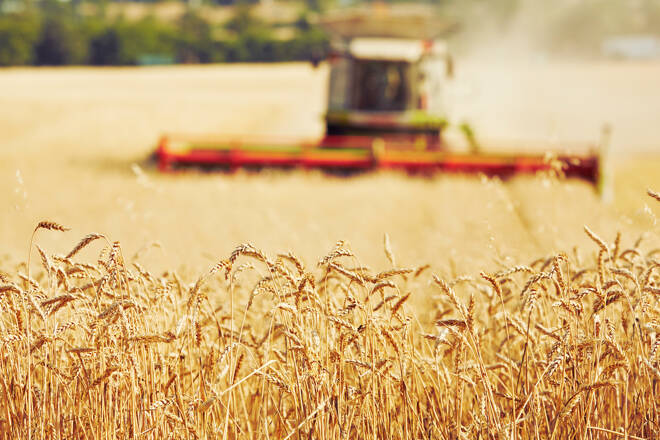Advertisement
Advertisement
Agriculture Rally Resumes Led by Coffee, Wheat and Sugar
By:
The cost of your breakfast and food in general continues to rise, and following a few months of sideways trading, the Bloomberg Agriculture index, which tracks a basket of major food commodity futures, reached a fresh five-year high this week. Apart from troubled weather reducing available supply there are several other reasons playing a their part and in this update we take a look at some of those, including the reasons why coffee and wheat are two of the hottest food commodities this year.
The cost of your breakfast and food in general continues to rise, and following a few months of sideways trading, the Bloomberg Agriculture index, which tracks a basket of major food commodity futures, reached a fresh five-year high this week. The table below shows the commodities with the biggest impact this year has been led by coffee, edible oils, wheat and sugar.
There are individual reasons behind the strong gains, but what they all have in common has been a troubled weather year, a post pandemic jump in demand leading to widespread supply chains disruptions and more recently rising production costs via surging fertilizer prices and rising cost of fuels, such as diesel.
La Ninã weather pattern
La Ninã weather pattern which can lead to floods, drought and cooler temperatures around the world returned to haunt producers this year, and recent forecasts say it will prevail through the coming northern hemisphere winter. In large swathes of South America and parts of North America a La Ninã is normally accompanied by drought, whereas in Australia and parts of Southeast Asia it is often resulting in heavy rainfall.
Fertilizer prices
Fertilizer prices have skyrocketed during the past few months as a result of soaring natural gas prices which have forced some European production plants to halt or reduce production. Fertilizer indices tracking prices in North America and Western Europe both trades more than 200% above their five-year averages. The surge has raised concerns farmers may reduce their usage of fertilizers or shift more acres into crops that require less nutrients. A drop in yields could drive prices even higher, thereby worsening already strong food inflation.
Supply chain problems/disruptions
Supply chain problems/disruptions: We are all familiar with stories about port congestion, lack of containers and surging prices on all the major routes around the world, especially from the production hub in Asia to major ports in Europe and the U.S. These problems began as a result of the pandemic which initially drove a major amount of order cancellations before the world a few months later went on a massive spending spree for consumer goods as the service sector grinded to a halt. These developments together with port disruptions due to continued Covid outbreaks helped trigger disruptions that to this day continue to cause problems for shippers of goods, including many of the food commodities that are transported in special containers.
Arabica coffee
Arabica coffee trades at a nine-year high at $2.38 per pound with the supply outlook looking increasingly tight following an annus horribilis in Brazil where frost and drought dealt a blow to the 2021 crop. In addition to weather, the market also had to deal with lack of shipments and high container rates, surging fertilizer prices and roasters in Europe struggling to source supplies from alternative producers in Columbia and Vietnam.
If that wasn’t enough, there is now also a growing risk of civil war in Ethiopia, the world’s third biggest grower of the Arabica bean. What may prove to be even worse over the coming months is that the flowering, or lack of, for the 2022 on-season crop is pointing to another low production year.
The break above $2.25, the 2014 high may signal a market running towards $3, a record level that was last seen in 2011.
Wheat
From a global food security perspective, the ongoing rally in global wheat prices is an even bigger concern. This week we have seen Chicago wheat futures climb to their highest level in nine years, while here in Europe, the benchmark Paris Milling Wheat contract trades just below €300 per tons, its highest price ever. Just like coffee, weather worries are the main driver, following a poor harvest in North America together with a year-on-year decline in exports from Russia, the world’s largest shipper.
These developments have triggered increased demand for European sourced wheat, and with the prospect of another potentially challenging crop year in 2022 caused by weather and high fertilizer costs, some of the major importers have recently been stepping up their pace of purchase in order to cool local food prices, and to secure supplies ahead of winter. With buyers increasingly competing for supplies the market will look for some relief from the upcoming and promise-looking harvests in Argentina and Australia, taking place from now until January.
One of the most actively traded ETF tracking the agriculture sector, the Invesco DB Agriculture Fund, broke higher last week to reach a four-year high. The index tracks the performance of 11 major futures markets spread across grains, softs and livestock.
This article is provided by Saxo Capital Markets (Australia) Pty. Ltd, part of Saxo Bank Group through RSS feeds on FX Empire
About the Author
Ole Hansencontributor
Ole Hansen joined Saxo Bank in 2008 and has been Head of Commodity Strategy since 2010.
Advertisement
